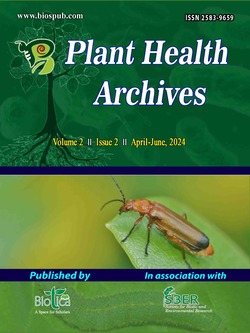
Phytocoenology Study of Weeds of Rice Crop with Edaphic Variation: An Analysis from Jhargram, West Bengal, India
Dhiman Mukherjee*
Regional Research Station (Red & Laterite Zone), Bidhan Chandra Krishi Viswavidyalaya, Jhargram, West Bengal (721 507), India
Golam Moinuddin
Regional Research Station (Red & Laterite Zone), Bidhan Chandra Krishi Viswavidyalaya, Jhargram, West Bengal (721 507), India
Subhendu Jash
Regional Research Station (Red & Laterite Zone), Bidhan Chandra Krishi Viswavidyalaya, Jhargram, West Bengal (721 507), India
DOI: https://doi.org/10.54083/PHA/2.2.2024/31-36
Keywords: Density, IVI, Phytocoenology, Rice, Weeds
Abstract
Under edaphic fluctuation, the current study explains the phytosociological characteristics and weed distribution patterns in transplanted rice crops. Present work was done in Jhargram block, West Bengal, during kharif season 2022 and 2023. For every weed species, analytical quantitative characters were determined, such as relative density, relative dominance and important value index. There were 15 (6 grassy, 6 BLWs, 3 sedge), 14 (4 grassy,6 BLWs, 4 sedge), 16 (5 grassy, 8 BLWs, 3 sedge) and 11 (3 grassy, 5 BLWs, 3 sedge) weeds species found in Jhargram, Binpur I and Binpur II and Nayagram block of Jhargram district, respectively. Observation showed that, the relative density of single plant species at Jhargram Block, Cynodon dactylon was the predominant grassy weed; however, relative density of BLWs (Broad Leaved Weeds) and sedges, more seen with Euphorbia hirta, Amaranthus spinosus and Cyperus sp., respectively. Importance Value Index (IVI) more reported with Cynodon dactylon for grasses, Ludwigia parviflora and Euphorbia hirta for BLWs and Cyperus difformis for sedges. In Binpur I, Cynodon dactylon for grasses, Ludwigia parviflora for BLWs and Cyperus rotundus for sedges, were the predominant weed species with highest IVI. In Binpur II, block, more IVI found with Paspalum scorbiculatum for grasses, Euphorbia hirta and Ludwigia parviflora for BLWs and Cyperus rotundus for sedges. In Nayagram, block, relative abundance was observed more with Echinochloa colona, Hydrolea zeylanica and Cyperus rotundus for grasses, BLWs and sedges, respectively. More number of BLWs was observed throughout the observation followed by grasses in case of Jhargram, Binpur I and sedges in Binpur II and Nayagram block. This baseline information become very imperative for future research as well as for farming community to choose right kind of competitive crops and cropping pattern in the red-latertic zone.
Downloads
not found
Reference
Concenço, G., Ceccon, G., Correia, I., Leite, L., Alves, V., 2013. Occurrence of weed species under crop succession. Planta daninha 31(2), 359-368. DOI: https://doi.org/10.1590/S0100-83582013000200013.
Duary, B., Mukherjee, A., Bhowmick, M.K., 2015. Phyto-sociological attributes of weed flora in major crops of red and lateritic belt of West Bengal. Indian Journal of Weed Science 47(1), 89-92.
Ewald, J., 2003. A critique for phytosociology. Journal of Vegetation Science 14(2), 291-296. DOI: https://doi.org/10.1111/j.1654-1103.2003.tb02154.x.
Kumar, S., Rana, S.S., Sharma, N., Iqbal, R.K., Qureshi, H., Anwar, T., Syed, A., Elgorban, A.M., Eswaramoorthy, R., 2023. Weed phyto-sociology and diversity in relation to conservation agriculture and weed management strategies in Northwestern Himalayas of India. Journal of King Saud University - Science 35(6), 102728. DOI: https://doi.org/10.1016/j.jksus.2023.102728.
Mukherjee, D., 2020. Effect of different crop establishment and weed control options on yield and nutrient uptake in rice. Annals of Agricultural Research 41(3), 266-275.
Mukherjee, D., 2021. Weeds biodiversity: Challenges and opportunity in current context. Chapter 3. In: Biological Diversity: Current Status and Conservation Policies (Volume 1). (Eds.) Kumar, V., Kumar, S., Kamboj, N., Payum, T., Kumar, P. and Kumari, S. Agro Environ Media Publishers, Agriculture and Environmental Academy, Haridwar, Uttarakhand, India. pp. 46-66. DOI: https://doi.org/10.26832/aesa-2021-bdcp-03.
Mukherjee, D., 2023a. A case study: Weed identification and control measure in moisture stress conditions under Red-Lateritic Belt of West Bengal. Agri Tech Today 1(9), 6-8.
Mukherjee, D., 2023b. Modern Approaches of Organic Weed Prevention Measures in Crop Fields. In: Recent Advancement in Organic Farming. (Eds.) Bhakta, J.N. and Rana, S. Nova Science Publisher. pp. 65-91. DOI: https://doi.org/10.52305/KDXB1757.
Mueller-Dombois, D., Ellenberg, H., 1974. Community sampling: The releve method. In: Aims and Methods of Vegetation Ecology. John Wiley & Sons, New York. pp. 95-133.
Saavedra, M., Garcia-Torres, L., Hernandez-Bermejo, E., Hildago, B., 1990. Influence of environmental factors on the weed flora in crops in the Guadalquivir Valley. Weed Research 30(5), 363-374. DOI: https://doi.org/10.1111/j.1365-3180.1990.tb01723.x.
Shah, M.H., Mandal, B., Mukherjee, D., Kundu, S., 2023. Effect of weed management in transplanted rice under New Alluvial Zone of West Bengal. The Pharma Innovation Journal 12(8), 1834-1838.
Sutradhar, J., Lokho, A., Das, A.P., 2018. Survey of weed flora of rice fields in Lateritic Belt and Alluvial Zone (Bindhya and Gangetic Alluvium) of Bardhaman District, West Bengal, India. Chapter 21. In: Angiosperm Systematics: Recent Trends and Emerging Issues, Volume 1. (Eds.) Agnihotri, P. and Khuraijam, J.S. M/S Bishen Singh Mahendra Pal Singh, Uttarakhand, India. pp. 391-404.
Teli, S., Saha, A., Debbarma, B., 2023. Climate smart weed management practices. Plant Health Archives 1(1), 03-04. DOI: https://doi.org/10.54083/PHA/1.1.2023/03-04.
